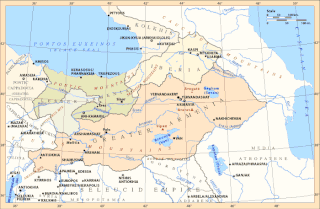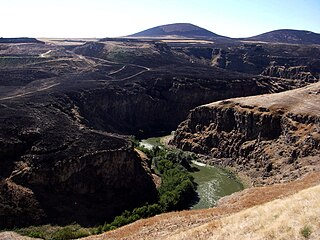
Saint Gregory the Illuminator is the patron saint and first official head of the Armenian Apostolic Church. He was a religious leader who is credited with converting Armenia from paganism to Christianity in 301. Armenia thus became the first nation to adopt Christianity as its official religion.

Armenia lies in the highlands surrounding the Biblical mountains of Ararat. The original Armenian name for the country was Hayk, later Hayastan, translated as the land of Haik, and consisting of the name of the ancient Mesopotamian god Haya (ha-ià) and the Persian suffix '-stan' ("land"). The historical enemy of Hayk, Hayastan, was Bel, or in other words Baal.

Transcaucasia, or the South Caucasus, is a geographical region in the vicinity of the southern Caucasus Mountains on the border of Eastern Europe and Western Asia. Transcaucasia roughly corresponds to modern Georgia, Armenia, and Azerbaijan. Total area of these countries is about 186,100 square kilometres. Transcaucasia and Ciscaucasia together comprise the larger Caucasus geographical region that divides Eurasia.

Armenians are an ethnic group native to the Armenian Highlands.

Ijevan, is a town and urban municipal community in Armenia serving as the administrative centre of Tavush Province. It is located at the center of the region, at the foot of Ijevan ridge of Gugark Mountains, on the shores of Aghstev River. As of the 2011 census, the population of the town was 21,081, making it the most populated town in the province. As per the 2016 official estimate, the population of Ijevan is around 20,700.

Erzurum is a city in eastern Anatolia. It is the largest city in and eponymous capital of Erzurum Province. It is situated 1757 meters (5766 feet) above sea level. Erzurum had a population of 361,235 in the 2000 census, increasing to 367,250 by 2010.

The Armenian Kingdom of Cilicia, also known as the Cilician Armenia, Lesser Armenia, or New Armenia, was an independent principality formed during the High Middle Ages by Armenian refugees fleeing the Seljuq invasion of Armenia. Located outside the Armenian Highland and distinct from the Armenian Kingdom of antiquity, it was centered in the Cilicia region northwest of the Gulf of Alexandretta.

Shusha, or Shushi, is a city in the disputed region of Nagorno-Karabakh in the South Caucasus. It has been under the control of the self-proclaimed Artsakh Republic since its capture in 1992 during the Nagorno-Karabakh War. However, it is a de jure part of the Republic of Azerbaijan, with the status of an administrative division of the surrounding Shusha Rayon. According to the Resolution No.884 of the United Nations Security Council and the United Nations General Assembly by the Resolution No.62/243, the territorial integrity of Azerbaijan was partially recognized and they include a demand of withdrawal of the Armenian forces. Situated at an altitude of 1,400–1,800 metres (4,600–5,900 ft) in the picturesque Karabakh mountains, Shusha was a popular mountain recreation resort in the Soviet era.
Abas I of Armenia was king of Armenia from 928 to 953. Abas was of the royal Bagratuni Dynasty. He was the son of Smbat I and the brother of Ashot "Yerkat" II. In contrast to the way his predecessors' ruled, Abas' reign was marked by years of peace, stability, and prosperity that Armenia had not enjoyed for decades.
The Armenian calendar is the calendar traditionally used in Armenia.

The Satrapy of Armenia (Armenian: Սատրապական Հայաստան Satrapakan Hayastan; Old Persian: Armina or Arminiya, a region controlled by the Orontid Dynasty was one of the satrapies of the Achaemenid Empire in the 6th century BC, which later became an independent kingdom. Its capitals were Tushpa and later Erebuni.

The Armenian Oblast or Armenian Province was an oblast (province) of the Caucasus Viceroyalty of the Russian Empire that existed from 1828 to 1840. It corresponded to most of present-day central Armenia, the Iğdır Province of Turkey, and the Nakhichevan exclave of Azerbaijan. Its administrative center was Erivan (Yerevan).

The Akhurian, Akhuriyan, Akhuryan or Akhouryan is a river in the South Caucasus. It originates in Armenia and flows from Lake Arpi, along the closed border with Turkey, forming part of the geographic border between the two states, until it flows into the Aras River as a left tributary near Bagaran. The Akhurian drains an area of about 9,500 square kilometres (3,700 sq mi) and has total length of 186 kilometres (116 mi).
The name Armenia enters English via Latin, from Ancient Greek Ἀρμενία. The Armenian endonym for the Armenian people and country is hayer and hayk’, respectively. The exact etymology of the name is unknown, and there are various speculative attempts to connect it to older toponyms or ethnonyms.

The Battle of Ani was fought between the forces of the Kingdom of Armenia under Vahram Pahlavouni and the Byzantine Empire in 1042. The Byzantine Empire was soundly defeated, with up to 20,000 dead.
Ervand Abrahamian is a historian of Middle Eastern and particularly Iranian history.

Urartu, which corresponds to the biblical mountains of Ararat, is the name of a geographical region commonly used as the exonym for the Iron Age kingdom also known by the modern rendition of its endonym, the Kingdom of Van, centered around Lake Van in the historic Armenian Highlands.

The Church of the Holy Seal is an 18th-century Armenian church in Old Tbilisi, Georgia. It was built between 1703 and 1711, and reconstructed in 1780.













